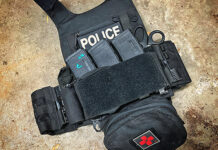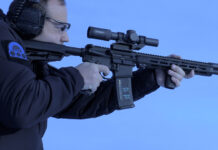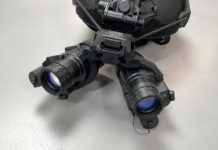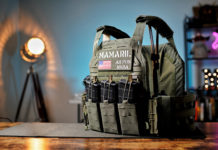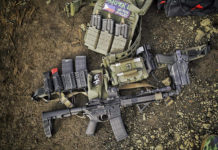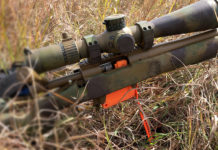Over the next few months, I will run a few different trigger systems through a project Glock that I have. I was initially going to put an Agency Arms trigger up against a Zev Technologies trigger system as I personally own an Agency, and I’ve heard great things about Zev.
As per usual, I want to see if the trigger will fail, if there are performance enhancements inherent in the trigger system itself, and if those enhancements (perceived or otherwise) are worth the money.
To my surprise, I was contacted by John from Innovative Gunfighter Solutions, LLC (IGFS), who threw his hat in the ring as well, and offered to stack his newest Enhanced Duty Trigger (EDT) up against Agency and Zev. Gotta respect that. John and I worked the details out offline, however in the interest of full disclosure, I committed to giving his trigger system a fair shake, and that since I didn’t purchase it outright, I would return it to him at the end of the evaluation period to ensure my objectivity.
A few days later, I received the EDT trigger system from IGFS. Along with the trigger system was a 2-page thoughtful write-up; some of which I have reprinted here so that readers can understand the background and thought process of the development of the EDT.
Boutique triggers can be a finicky thing. In an attempt to smooth, lighten, and sharpen up a custom trigger, different manufacturers or custom smiths have different methods and techniques to achieve a “custom” feel. The enhancements however, need to be balanced with reliability and maintain the original safety designs inherent in that particular weapon platform. If the design changes how the pistol was originally intended to function, the end user accepts the risk that their pistol may not function as intended, or in the worst case scenario, it fails at a critical moment which compromises the safety of the end user, or those around them.
IGFS kept this maxim in mind when their EDT was designed. Regarding safety, the EDT was designed with some of the following goals in mind: their trigger must perform as reliably as factory, all three standard internal Glock safeties must function as originally designed; the trigger itself is non-adjustable and unable to be disassembled or modified by the end user, and utilize a stiffer safety spring to ensure the internal trigger safety worked if the pistol was dropped.
Trigger fabrication is interesting. I find the trigger itself to frankly be unaesthetically pleasing, but looks are not a factor for me when it comes to the functionality of gear and components. The trigger itself is non-adjustable; pre-travel, and over-travel cannot be further tuned by the end-user to avoid any inadvertent "enhancements" that could render the trigger unsafe.

Immediately noticeable is the flat faced and vertically-serrated trigger shoe. The vertical serrations provide a tactile, non-slip feel, and the flat face influences the user to press straight back against the trigger, resulting in an even press to the rear. The trigger shoe itself is permanently fixed to the trigger bar, and like a standard Glock trigger, the pins are pressed in from the left, but do not push all the way through the shoe, preventing disassembly.
I mentioned before that the trigger is not tunable by the end user. IGFS did not want to use adjustment screws in their assembly since pre-travel and over-travel set screws are typically of harder material than the trigger bar, resulting in degradation of the bar material itself over time, thus introducing the necessity to re-set and adjust the set screws as wear inevitably sets in. Instead, IGFS tuned the pre-travel stop inside of the body of the trigger itself, again rendering it non-adjustable to the end user, but simultaneously allowing for the trigger bar end to rest flat against the inside of the trigger shoe.
The flat face of the shoe is noticeably positioned further forward than other triggers out there, which IGFS believes is ergonomically superior for most shooters in that the trigger finger is more properly aligned for a straight-back press, hopefully enhancing a smooth trigger pull, consistency, and accuracy when shooting from reset.
Installation
There’s not really much to say about the installation of the IGFS EDT; anyone with basic mechanical ability and a knowledge of the standard Glock trigger assembly should be able to accomplish the swap in short order. I conducted a function check and dry fired for about 20 minutes to see if the wheels would fall off, but dry fire drills indicated that everything was in working order.
Initial Impressions
Aesthetic misgivings aside, the EDT seems quite sturdy, and it should, as its made from hard coat anodized T6061 aluminum. I noted above that the flat face of the trigger shoe is positioned further forward than other aftermarket triggers out there, and it definitely is noticeable. For other Glocks I have with different aftermarket triggers, I’ve actually swapped out a backstrap or two in order to be able to grip the gun to my liking. That step is not necessary with the EDT. Now, feel is subjective and personal, so keep in mind that I am a small guy. I have short stubby fingers and wide palms, and my handspan from thumb tip to the tip of my pinky is a smidge above 8", so for me, where the EDT trigger rests is just on the right side of comfortable.

When one typically thinks of an aftermarket trigger, we conjure images of a no-creep, "glass break, " 1911-style trigger break with zero over-travel and the sounds of angels singing as the clouds part upon trigger press. Let’s dispel any of those pre-conceptions right from the get-go. This trigger is for the Glock platform, which will never be in the same category as a 1911, or a crisp DA/SA finely tuned pistol.
The pre-travel of the EDT is substantial, and I like it. The EDT has a stronger trigger safety spring, and there is a solid, positive pre-travel period, however it is quite smooth with no grittiness to it.
The trigger stacks a bit on the break, but without the sponginess usually associated with a Glock trigger, and once the trigger does break, over-travel is non-existent. What one will notice immediately though, is that due to the stronger trigger safety spring, it almost feels like the trigger is pushing the trigger finger forward to reset, which feels positive, but not jarring in any sense.
I have approximately 400 rounds through my project Glock with the IGFS EDT trigger installed, and it’s smoothed out and performs flawlessly so far. I see the EDT as a very solid contender; easily better than a standard Glock trigger. Its main selling points that I can see so far are the design concepts geared towards reliability, and frankly the robustness of the trigger itself. I really like that fact that the trigger can’t be monkeyed with, and that there are no set screws to work loose and require readjustment. This truly is a set-it-and-forget-it type of a trigger system that doesn’t try to reinvent the wheel to squeeze more performance out of a combat handgun. The IGFS EDT retails at $155.00, which is competitively priced against other trigger systems out there.

The next step is to remove it and replace it with the Zev Technologies trigger; I’ll post up another article on initial impressions of the Zev, then the Agency Arms trigger will be after that. This series will culminate in a breakdown of the pros and cons of each system as compared to each other, and a buyer’s guide run-down of sorts.
Stay tuned, Zev Technologies is up next.

Check out Chris Tran on Facebook and Instagram.
* The views and opinions expressed on this web site are solely those of the original authors and contributors. These views and opinions do not necessarily represent those of Guns & Tactics Magazine,
the administrative staff, and/or any/all contributors to this site.



